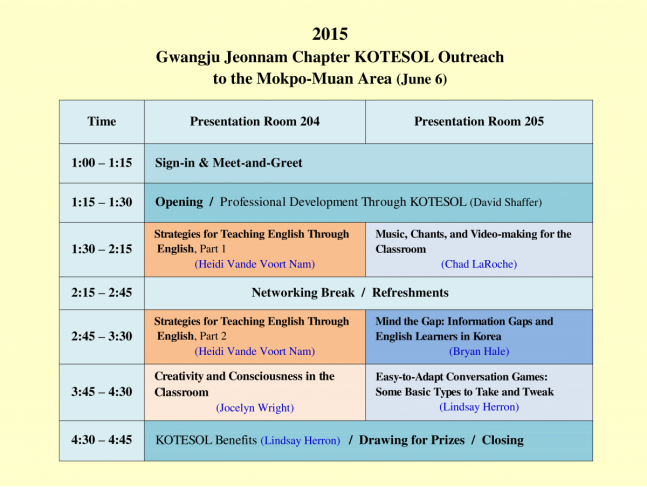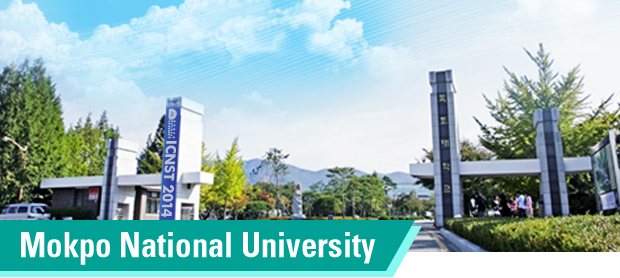
Gwangju-Jeonnam KOTESOL June Outreach
Time: Saturday, June 6, 2015, 1:00 p.m.
Place: Mokpo National University (Muan, Jeonnam), Bldg. A10, Rm. 204 & 205
Directions to Venue: http://koreatesol.org/content/directions-mokpomuan-outreach
Google Map
----- Workshop Presentations -----
1:30 pm: Strategies for Teaching English Through English, Parts 1 & 2
-- Heidi Vande Voort Nam (Chongshin University, Seoul)
3:45 pm: Creativity and Consciousness in the Classroom
-- Jocelyn Wright (Mokpo National University)
1:30 pm: Music, Chants, and Video-making for the Classroom
-- Chad LaRoche
2:45 pm: Mind the Gap: Information Gaps and English Learners in Korea
-- Bryan Hale
3:45 pm: Easy-to-Adapt Conversation Games: Some Basic Types to Take and Tweak
-- Lindsay Herron
----- Workshop Schedule -----

>>> Schedule available in PDF format at bottom of page.
Presentation Abstracts and Presenter Biographical Sketches
.
Strategies for Teaching English Through English
Heidi Vande Voort Nam
Teaching English through English (TETE) can have many benefits: it increases comprehensible input and multiples the amount of authentic communication in the target language. In recognition of these benefits, the Ministry of Education has recommended TETE; however, many teachers find TETE difficult to implement in their own classes. Successful introduction of TETE requires not only familiarity with key teaching expressions, but also teaching techniques that help students comprehend the classroom instructions. This workshop will demonstrate five techniques for increasing student comprehension of classroom English: using simple language, using manageable chunks, modifying delivery, using body language, and monitoring comprehension. Workshop participants will practice translating complex classroom instructions into student-friendly expressions and generating effective comprehension questions.
The Presenter
 Heidi Vande Voort Nam holds an MA TESL/TEFL from the University of Birmingham. She currently teaches in the Department of English Education at Chongshin University, where she prepares English education majors for student teaching and for the national English teachers’ exam. Heidi also teaches beginner-level general English courses, including special courses for North Korean and Chinese students. Within KOTESOL, Heidi serves as a presenter for Korea Teacher Training (KTT) and facilitates KOTESOL’s Christian Teachers Special Interest Group (CT SIG), a group that hosts meetings and online discussions for Christian English teachers. Heidi lives in Seoul with her husband TaekHyeon Nam, who is a public high school English teacher, and their children, Joseph and Miriam.
Heidi Vande Voort Nam holds an MA TESL/TEFL from the University of Birmingham. She currently teaches in the Department of English Education at Chongshin University, where she prepares English education majors for student teaching and for the national English teachers’ exam. Heidi also teaches beginner-level general English courses, including special courses for North Korean and Chinese students. Within KOTESOL, Heidi serves as a presenter for Korea Teacher Training (KTT) and facilitates KOTESOL’s Christian Teachers Special Interest Group (CT SIG), a group that hosts meetings and online discussions for Christian English teachers. Heidi lives in Seoul with her husband TaekHyeon Nam, who is a public high school English teacher, and their children, Joseph and Miriam.
____________________
Creativity and Consciousness in the Classroom
Jocelyn Wright
This workshop is inspired by a new contentbased English class I am teaching this spring which involves looking at social issues related to happiness and well-being, peace and conflict, diversity and discrimination, sustainable development, communications and technology, etc. from creative points of view. The course, which is also projectbased, aspires to form students who are (more active) global citizens socially responsible, globally competent, and civically engaged (Morais & Ogden, 2011). As such, it aims to be transformative.
In this workshop, we will first define creativity and discuss its characteristics. We will also look at some creative ideas for raising awareness about significant social issues, using art and audio-visual media. Then, we will discuss tested creative project options. Participants will be invited to share their ideas and experience. Given the importance of the very in-demand skill of creativity and the many social problems we face in today’s global world, finding ways to incorporate both elements into our lessons seems well worth taking a closer look at. Come join me in this pursuit!
Reference
Morais, D. B., & Ogden, A. C. (2011). Initial development and validation of the global citizenship scale. Journal of Studies in International Education, 15, 445-466.
The Presenter
 Jocelyn Wright works in the Department of English Language and Literature at Mokpo National University. She has degrees in linguistics and education and is also CELTA certified. She has been teaching English in Korea at the university level for over six years, is actively involved in KOTESOL at the chapter level, and coordinates the local Reflective Practice Special Interest Group (RP-SIG). Her many interests include professional development and critical pedagogy.
Jocelyn Wright works in the Department of English Language and Literature at Mokpo National University. She has degrees in linguistics and education and is also CELTA certified. She has been teaching English in Korea at the university level for over six years, is actively involved in KOTESOL at the chapter level, and coordinates the local Reflective Practice Special Interest Group (RP-SIG). Her many interests include professional development and critical pedagogy.
____________________
Music, Chants, and Video-making for the Classroom
By Chad LaRoche
As teachers of English, many of us are often faced with a common problem when handed a textbook to teach from: A lack of interesting or engaging material suitable for our students. As a teacher of 5th- and 6th-grade elementary school students, I found this to be the case when it came to teaching my textbook’s musical chants, especially to 6th-graders, who would often retch at the reality of another chant they had to do. As a lover and performer of music and the drums, I chose to inject my own passion into the classroom in place of the CD-ROM-based songs. What I discovered was an engaged and participatory classroom environment that led to a lasting impression of the target language in addition to the creation of a stronger student rapport. Over time, I began experimenting with different ways to make the chants more interactive. I also began to incorporate another personal interest, videography, into the classroom by filming role-plays and creating student centered movies. These video-based activities have given young learners a chance to view and reflect on their own usage of the English language, boosted their motivation and excitement for English, as well as provided creative outlets in which to use the language.
In my presentation, I will provide an interactive demonstration of activities utilizing rhythm, music, and chants in the classroom that teachers can use regardless of their own musical ability. Inviting audience participation, we will look at ways that we can turn simple lines of text from the textbook into our own creation of musical, rhythmic, and interactive dialogue. Two more demonstrations will show the use of rhythmic reading, a method of spicing up reading assignments and exercising reading fluency, as well as the use of musical instrumentals found on YouTube to replace uninspiring textbook chants. The remainder of the presentation will be dedicated to video creation in the classroom for the purpose of student reflection, motivation, and creativity. I will show examples of student-centered video projects I’ve made with my students and demonstrate the simple tools needed for teachers to create their own.
The Presenter
 Chad LaRoche is a guest English teacher with EPIK (English Program in Korea). He has been living and teaching in Korea since October, 2013 at Dae Ban Elementary School and Pung Young Elementary School. After receiving his BA in Communications, Chad worked in TV production at a news station for three years before joining the U.S. Peace Corps and teaching at a secondary school in St. Vincent and the Grenadines. An interest in teaching has brought Chad to South Korea, and Korea has put him on track for an MA in TESOL set to begin at SIT Graduate Institute in September 2015.
Chad LaRoche is a guest English teacher with EPIK (English Program in Korea). He has been living and teaching in Korea since October, 2013 at Dae Ban Elementary School and Pung Young Elementary School. After receiving his BA in Communications, Chad worked in TV production at a news station for three years before joining the U.S. Peace Corps and teaching at a secondary school in St. Vincent and the Grenadines. An interest in teaching has brought Chad to South Korea, and Korea has put him on track for an MA in TESOL set to begin at SIT Graduate Institute in September 2015.
____________________
Mind the Gap: Information Gaps and English Learners in Korea
By Bryan Hale
In an information gap activity, students have different information and communicate with each other to share it. Normally students have a task to complete which requires exchanging information.
When I first started using information gap activities with elementary and middle school classes in Korea, there were problems! Some students would use Korean or simply show each other the answers. Perhaps worse, students treated the activities as drills, and used formulaic language very mechanically. It seemed like information gaps required me to do a lot of classroom policing for little communicative value.
In a critique of communicative teaching, Michael Swan argued against information gaps which ask students to exchange "unmotivating, imposed information," and called for more personal exchanges where "students are simply asked to talk about themselves" (Swan, 1985, p. 84). Scott Thornbury has paraphrased this as "the best information gap is the information gap that exists between the people in the room" (The New School, 2013, 00:53:25).
This ideal was attractive, but daunting. I was teaching students who shared a first language, who often already knew each other very well and at the same time could be reluctant to share personal information, and who didn’t always have much motivation to use English. Between the classroom reality and the ideal, I felt like giving up on information gaps.
However, with more time, I have found that when information gaps do work with my students, they are very useful. Students use language with increased fluency and purpose. Students negotiate language with each other. Students take ownership of the activity.
In this session, we will discuss the classroom management of gap activities in classrooms in Korea, and also the design or adaptation of gap tasks for students in Korea. I will share my ideas about why certain information gaps have worked for me and my students, and we will consider some different activity ideas in terms of our own teaching settings.
References
Swan, M. (1985). A critical look at the communicative approach 2. ELT Journal, 39(2), 77–87.
The New School, NY. (2013, July 22). Communicative Language Teaching: What We Have Gained (And What We Might Have Lost) - A Conversation Between Jeremy Harmer and Scott Thornbury [Video file]. Retrieved from https://www.youtube.com/watch?v=hoUx036IN9Q
The Presenter
 Bryan Hale is from Australia, where he first learned about information gaps while getting a CELTA (Certificate in English Language Teaching to Adults). A lot of Bryan’s experience is with teaching middle school and older elementary students, but he has experience in Korea teaching students of all ages from very young to adult. Bryan currently teaches at Sunkyung Academy in Gwangju and is the Membership Coordinator for the Gwangju-Jeonnam Chapter of Korea TESOL. Email: bryan.english.teacher@gmail.com
Bryan Hale is from Australia, where he first learned about information gaps while getting a CELTA (Certificate in English Language Teaching to Adults). A lot of Bryan’s experience is with teaching middle school and older elementary students, but he has experience in Korea teaching students of all ages from very young to adult. Bryan currently teaches at Sunkyung Academy in Gwangju and is the Membership Coordinator for the Gwangju-Jeonnam Chapter of Korea TESOL. Email: bryan.english.teacher@gmail.com
____________________
Easy-to-Adapt Conversation Games: Some Basic Types to Take and Tweak
Lindsay Herron
Are you looking for communication games for your English conversation class? This workshop can help! Participants will have the opportunity to experience a wide variety of games and game types, mostly drawn from the work of Jill Hadfield. All are communicative, and thus require students to listen and speak for a purpose; and all provide a strong, engaging context for language use. After trying each game type, participants will work in groups to transfer the basic structure to a sample lesson from an elementary school textbook, essentially creating a new game. By the end of the workshop, attendees will be thinking more creatively about how to approach games in their classes and will have three to five basic structures that can be readily adapted to any lesson they teach!
The focus of the workshop will depend on attendees’ interest. Attendees can choose from among these game types:
- Guessing games, in which one or more players have information, and the other players try to guess it;
- Search games or puzzle-solving games, in which players must talk with each other to gain lots of different information, and then use that information to solve a puzzle;
- Matching games, in which players try to match corresponding cards or information;
- Matching-up games, in which players each have a different list of possibilities, and then they use discussion and compromise to reach an agreement;
- Exchanging and collecting games, in which players have certain items they can exchange with other players in order to complete a set;
- Grouping games or combining activities, in which players use the given information to arrange themselves into a group;
- Arranging or sequencing games, in which players must exchange information in order to arrange something in a particular order.
.
The Presenter
 Lindsay Herron has been a visiting professor at Gwangju National University of Education since 2008. Prior to that, she taught English on a Fulbright grant at a boys’ high school in Jeju-do. She has a master’s degree in language education from Indiana University-Bloomington, a master’s in cinema studies from New York University, bachelor’s degrees in English and psychology from Swarthmore College, a CELTA, and the CELTA YL Extension. She is currently the First Vice-President of KOTESOL and Membership Committee Chair, Treasurer of the Gwangju-Jeonnam Chapter, and the new facilitator of the Multimedia and CALL Special Interest Group.
Lindsay Herron has been a visiting professor at Gwangju National University of Education since 2008. Prior to that, she taught English on a Fulbright grant at a boys’ high school in Jeju-do. She has a master’s degree in language education from Indiana University-Bloomington, a master’s in cinema studies from New York University, bachelor’s degrees in English and psychology from Swarthmore College, a CELTA, and the CELTA YL Extension. She is currently the First Vice-President of KOTESOL and Membership Committee Chair, Treasurer of the Gwangju-Jeonnam Chapter, and the new facilitator of the Multimedia and CALL Special Interest Group.

| Attachment | Size |
|---|---|
| 50.1 KB |


